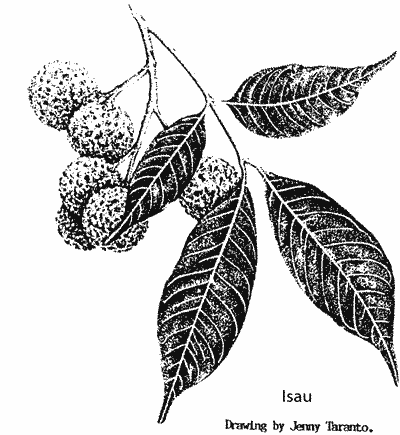
FIRST FRUITING OF ISAU
SCIENTIFIC NAME: Dimocarpus longana var. malesianus
FAMILY: Sapindaceae

I planted a few Isau (Dimocarpus longana var. malesianus) and Kakus (D. longana var. kakus) trees 5 years ago, some in full sun and some in more shaded positions. The Isau surrounded by other trees have grown the best for me, probably not because they like shade, but because I don't irrigate, and those exposed to the full dry season sun have spent more time, in the early years, "hanging in," than growing. So I was surprised, last year, to find a shaded Isau flowering, and was encouraged by the fruit set.
The red leaf flushes of Isau make it an attractive tree. The fruit is about an inch (25mm) across with green pebbly skin at maturity, ripening yellowish-green. The seed is similar to that of the longan (D. longana), measuring slightly less than half the fruit diameter (11 mm). The skin of Isau is thicker than that of longan.
My first impression, on eating the fruit from my first producing tree, was that the flesh was too thin to be worthwhile. However after eating a few, I was not disappointed. The flavour is of longan, but sweeter, very similar to the sweet longan cv, "Pon Ya."
ISAU'S PLACE IN THE SAPINDACEAE CALENDAR
My last fruit was picked from the ground in early August, while the first was tasted in early June; there was little difference in quality between them. It's a long cropping period - no doubt helped by the cool weather - and the thick skin which may discourage fruit piercing moth damage, from which my February longans sometimes suffer.
I now wish I'd planted more Isau trees. I was considering the fruit with the wrong attitude. I'd planted sufficient lychees and longans, so, when the more obscure longan-like fruits became available, I'd decided already that I preferred longan to lychee and even if these others were good, I'd probably still prefer longans. The important point, however, is the season when the fruits matures, not its degree of preference.
On my dry soil, Alupag (Litchi philippinensis) is the earliest of the Sapindaceous fruits, followed by lychee, longan and finally Isau. The Isau gives me the joy of a double longan season. This still leaves the Kakus, Sau and Spiny Longan - three other longan-like fruits already growing in North Queensland. Will they complement or extend the fruiting season?
SIGNIFICANCE FOR OTHER SAPINDACEOUS FRUITS
For the lovers of Rambutan, a fruit with a long season, the importance of allied species may seem less in regard to a fruiting calendar. But with Lait, Sibau, Pangkal, Titidan, Parih, Melajan, Buban, Presen, and Meritam (Pulasan) offering exciting variation on the rambutan, it's hard to imagine at least one of these not being available throughout the year. Time and effort shall tell. The more members who grow these lesser-known fruits in different locations, the truer picture of their worth will be shown. The Sapindaceae are a hardy family, easy to grow and with good cropping potential. Your tree could be the favoured one!
DATE: September 1992
* * * * * * * * * * * * *
